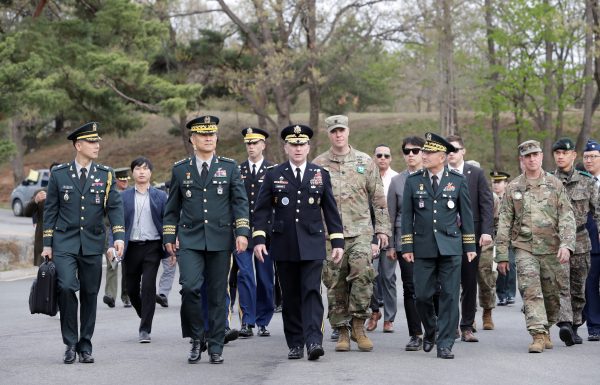There are concerns over the implications a revitalisation of the UNC would have for the transfer of wartime operational control of the Combined Forces Command (CFC) to the South Korean government. Seoul and Washington have not come to an understanding on this. But one of the most crucial aspects of revitalising the UNC is defining its role in the context of the United States’ Indo-Pacific strategy.
In particular, the onus will be on Washington to define what role the UNC would take in a post-unification Korean Peninsula and how it fits into the US–China relationship. The UNC, despite its name, is primarily a US institution and authority over the UNC — according to UN Security Council Resolution 84 — lies in the hands of the US government.
Still, in recent years the UNC, which technically consists of the ‘sending states’ that participated as South Korean allies in the Korean War (1950–53), has been returning to its multinational roots. Former US Secretary of Defense James Mattis touted the multi-state essence of the UNC during the 2017 Shangri-La security dialogue, asserting that ‘sending states’ remain committed to preserving peace on the Korean Peninsula.
According to Vincent Brooks, previously the most senior US military officer in South Korea, the UNC could include more non-US military personnel in positions of responsibility — crucial to any revitalisation. Since 2018 there have been two non-US UNC deputy commanders: Wayne Eyre of the Canadian Army and current Deputy Commander Stuart Mayer of the Royal Australian Navy.
But as it stands, United States Forces Korea (USFK) constitutes the mainstay of the UNC’s ability to uphold the 1953 inter-Korean armistice, while also comprising a major component of the CFC.
While the UNC’s origins lie in a UN resolution empowering Washington to command forces aimed at maintaining peace on the Korean Peninsula, the CFC — whose main purpose is to deter North Korea from launching a conventional attack on South Korea — stems from the US–ROK Mutual Defense Treaty.
USFK, dual-purposed to serve the UNC and the CFC, includes two of the largest subdivisions within specific branches of the US armed forces — the 8th US Army and the 7th US Air Force. USFK is commanded by an Army four-star general, of which US law allows only seven in total.
By virtue of its size, USFK comprises a crucial feature in Washington’s broader Indo-Pacific strategy. US policy refers to its defence posture on the Korean Peninsula as the ‘linchpin’ of Indo-Pacific security.
The US Indo-Pacific Strategy is focussed on preventing China from re-ordering the US-led rules-based order in the Indo-Pacific. It also affirms that Washington remains committed to deterring North Korean aggression against the United States and its partners, underscoring the importance of the US–ROK alliance in Washington’s Indo-Pacific policies.
USFK’s role as the mainstay of the UNC’s ability to enforce the 1953 armistice and its prominent place in broader US strategy creates a complex situation. How would a more prominent UNC articulate how it can execute its mission as a multilateral force for peace separate to wider US strategic goals?
General Robert Abrams, who currently serves as the ‘triple hatted’ commander of USFK, the CFC and the UNC, roundly denies that the push for a greater role for the UNC is related to the Indo-Pacific strategy. The UNC’s mission of maintaining peace on the Korean Peninsula, though beneficial to the strategy, is separate from supporting deterrence in the context of the US–ROK mutual defence posture — even if USFK serves both aspects of the US military presence in South Korea.
Given the potential for shifts in the status quo on the Korean Peninsula diminishing the need for a staggering US defence presence, the UNC will need to be clear about what role, if any, it will serve beyond the maintenance of the 1953 armistice.
In the event of Korean unification under Seoul, as Kim Sung-han and Scott Snyder argue, China calculates that the removal of a North Korean existential threat to South Korea would reduce the need for South Korea to continue hosting US troops. Under such circumstances, Beijing would likely push for the ejection of US armed forces from the Korean Peninsula.
The future of the US military presence in a reunified Korea in the context of Seoul and Washington’s bilateral alliance would need to be resolved between South Korea and the United States, even as China exerts pressure on Seoul. Yet a revitalised UNC under Washington’s responsibility would constitute a significant extra element to the interplay between Seoul, Washington and Beijing over the presence of US military forces in a post-division Korean Peninsula.
Whatever function a revitalised UNC would serve, a failure to clearly delineate the UNC’s purpose from Washington’s strategic goals risks leading to confusion and miscalculations — particularly on China’s part — over US intentions in the context of a reunified Korean Peninsula.
Anthony V Rinna is a Senior Editor and a specialist on Russian foreign policy in East Asia for the Sino-NK research group.

